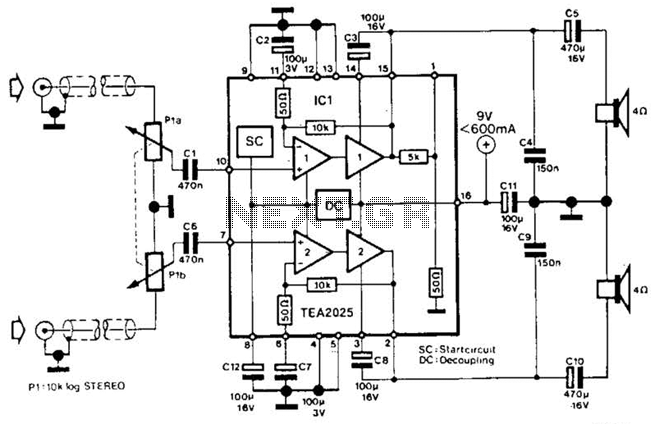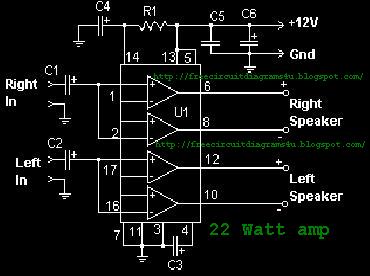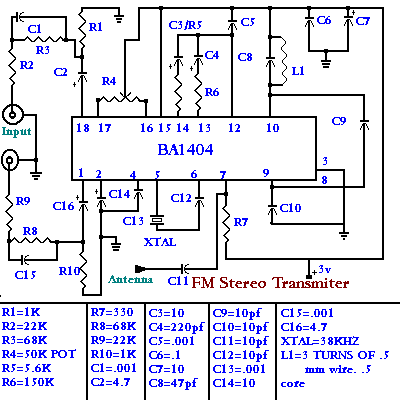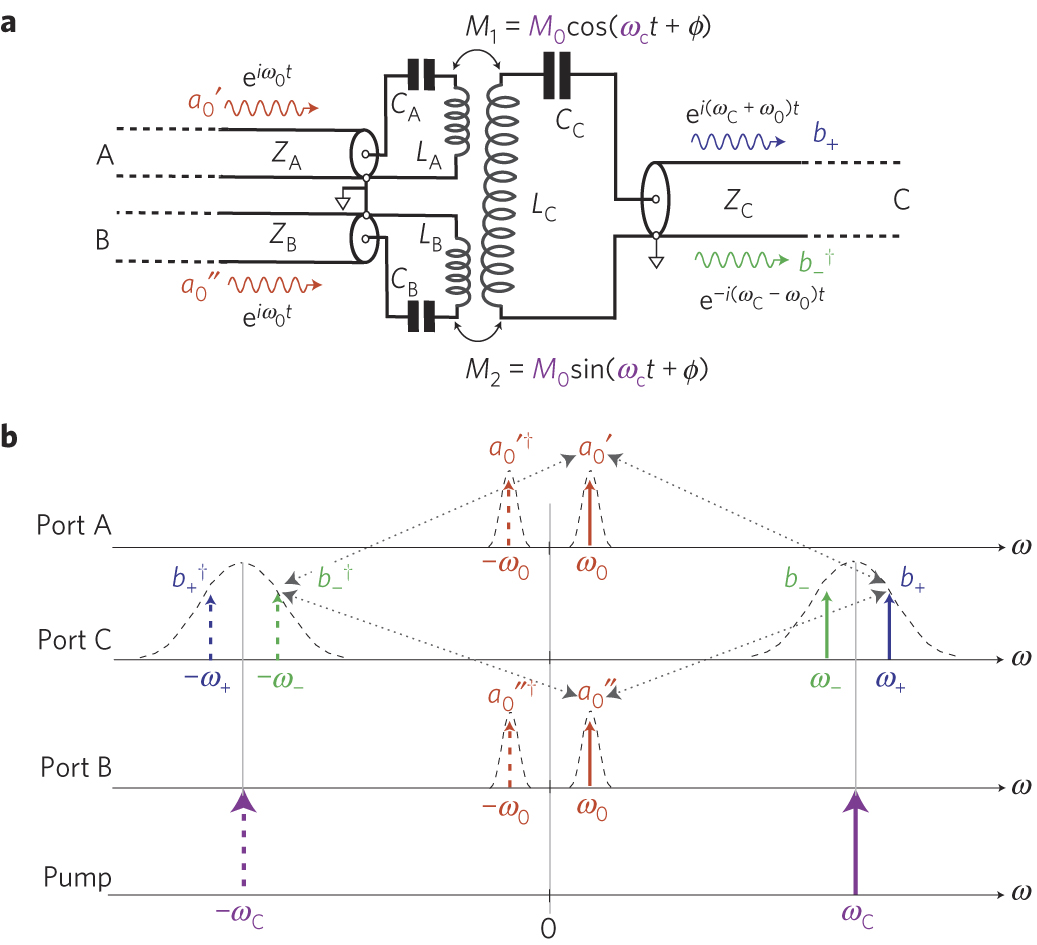
ba1404 fm stereo modulator
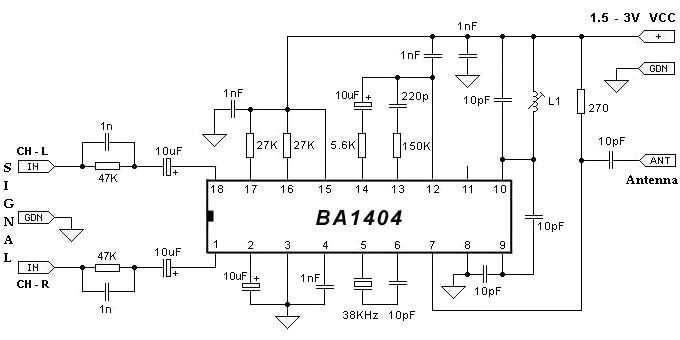
The BA1404 can be utilized to design a straightforward and effective FM stereo modulator electronic project. This BA1404 FM stereo modulator device operates within the FM broadcast band (75-108 MHz) and requires only a few common external components. The BA1404 FM stereo modulator IC encompasses all the necessary components to create a simple yet high-efficiency stereo transmitter circuit. The IC includes a stereo modulator that generates stereo composite signals, an FM modulator that produces FM signals, and an RF amplifier. The FM stereo transmitter generates composite signals consisting of a main (L+R) signal, a sub (L-R) signal, and a pilot (19 kHz) signal, utilizing a 38 kHz crystal oscillator.
The BA1404 FM stereo modulator is designed for applications where a compact and efficient stereo transmission is needed. The circuit is suitable for hobbyists and professionals looking to create a low-power FM transmitter. The architecture of the BA1404 includes a stereo modulator section that combines left and right audio channels into composite signals, which are essential for stereo broadcasting.
The operation begins with the audio input, where the left (L) and right (R) audio signals are fed into the stereo modulator. This modulator processes the signals to create the composite output, which includes the main signal (L+R) and the difference signal (L-R) along with the pilot tone (19 kHz). The pilot tone is crucial for stereo decoding on the receiving end, ensuring that FM receivers can accurately reproduce the stereo sound.
The FM modulator then takes these composite signals and modulates them onto a carrier frequency within the FM broadcast band. The carrier frequency is determined by the external components and the configuration of the circuit. The RF amplifier boosts the modulated signal to ensure it can be transmitted over a considerable distance without significant loss of quality.
To implement this circuit, a 38 kHz crystal oscillator is employed, which serves as a stable frequency reference for the modulation process. This oscillator is critical for generating the pilot tone and ensuring the integrity of the stereo signals. The choice of external components, such as resistors, capacitors, and the antenna, will influence the overall performance and range of the transmitter.
In summary, the BA1404 FM stereo modulator is a versatile IC that simplifies the design of FM stereo transmitters. It integrates multiple functions into a single package, making it an ideal choice for creating efficient and effective FM broadcasting solutions. With the appropriate external components and careful circuit design, high-quality stereo audio can be transmitted within the FM band, catering to various applications in audio broadcasting.Using BA1404 can be designed a very simple and useful fm stereo modulator electronic project. This BA1404 fm stereo modulator device works in FM broadcast band ( 75- 108MHz) and require few external common components. The BA1404 fm stereo modulator Ic contains all parts needed to design an simple high efficiency stereo transmitter circuit.
This IC contains a stereo modulator that creates stereo composites signals, an FM modulator that creates FM signals and a RF amplifier. The fm stereo transmitter develops composite signals made up of a main(L+R) signal and sub(L-R) signal and a pilot (19KHz) signal using a 38KHz crystal oscillators.
🔗 External reference
The BA1404 FM stereo modulator is designed for applications where a compact and efficient stereo transmission is needed. The circuit is suitable for hobbyists and professionals looking to create a low-power FM transmitter. The architecture of the BA1404 includes a stereo modulator section that combines left and right audio channels into composite signals, which are essential for stereo broadcasting.
The operation begins with the audio input, where the left (L) and right (R) audio signals are fed into the stereo modulator. This modulator processes the signals to create the composite output, which includes the main signal (L+R) and the difference signal (L-R) along with the pilot tone (19 kHz). The pilot tone is crucial for stereo decoding on the receiving end, ensuring that FM receivers can accurately reproduce the stereo sound.
The FM modulator then takes these composite signals and modulates them onto a carrier frequency within the FM broadcast band. The carrier frequency is determined by the external components and the configuration of the circuit. The RF amplifier boosts the modulated signal to ensure it can be transmitted over a considerable distance without significant loss of quality.
To implement this circuit, a 38 kHz crystal oscillator is employed, which serves as a stable frequency reference for the modulation process. This oscillator is critical for generating the pilot tone and ensuring the integrity of the stereo signals. The choice of external components, such as resistors, capacitors, and the antenna, will influence the overall performance and range of the transmitter.
In summary, the BA1404 FM stereo modulator is a versatile IC that simplifies the design of FM stereo transmitters. It integrates multiple functions into a single package, making it an ideal choice for creating efficient and effective FM broadcasting solutions. With the appropriate external components and careful circuit design, high-quality stereo audio can be transmitted within the FM band, catering to various applications in audio broadcasting.Using BA1404 can be designed a very simple and useful fm stereo modulator electronic project. This BA1404 fm stereo modulator device works in FM broadcast band ( 75- 108MHz) and require few external common components. The BA1404 fm stereo modulator Ic contains all parts needed to design an simple high efficiency stereo transmitter circuit.
This IC contains a stereo modulator that creates stereo composites signals, an FM modulator that creates FM signals and a RF amplifier. The fm stereo transmitter develops composite signals made up of a main(L+R) signal and sub(L-R) signal and a pilot (19KHz) signal using a 38KHz crystal oscillators.
🔗 External reference
